Work Health and Safety in Australian Education Sector: A Report
VerifiedAdded on 2020/03/01
|11
|2795
|122
Report
AI Summary
This report provides an in-depth analysis of Work Health and Safety (WHS) within the Australian education sector. It begins by highlighting the significance of WHS in Australia, particularly under the Work Health and Safety Act 2011, emphasizing its applicability to all workers, including educators, contractors, and volunteers. The report then delves into the specific WHS issues faced by the education sector, such as hazardous manual handling, stress, slips, and aggressive behavior, emphasizing the sector's role in shaping young individuals and the need for a safe learning environment. The report also presents and analyzes two key case laws: WorkCover v TAFE Commission, focusing on the safety of students during riding lessons, and Barry Johnson v State of New South Wales, concerning the employer's duty of care in protecting employees from violent students. Finally, the report concludes with recommendations for improving WHS in the education sector, including establishing a robust safety risk management system, addressing manual handling risks, and minimizing falls, slips, and trips to ensure a safe working environment for all involved.

Paraphrase This Document
Need a fresh take? Get an instant paraphrase of this document with our AI Paraphraser

WHS 2
Introduction
Work, health and safety are something which is given major significance in Australia,
particularly through the applicability of the Work Health and Safety Act, 2011 (Cth) (Tooma,
2012). Through this act, a framework has been provided which protects the safety, welfare and
health of all the workers at work. The people who are covered under this act include the workers,
contractors, employees, subcontractors, volunteers, apprentices and trainees. Through this act,
the primary safety and health is made the duty of the person who conducts the business or
undertaking (WorkCover Queensland, 2017).
In the following parts, a discussion has been carried regarding the work health and safety in
Australia, with a particular reference to the education sector. In this regard, the issues which are
faced in the education factors pertaining to the WHS have been highlighted. This is followed by
a discussion on the case laws where the education sector related cases in the matter of WHS have
been elucidated. Lastly, before concluding the entire discussion, certain recommendations have
been presented to deal with the issues highlighted regarding WHS in Australian education sector.
Issues of WHS in Education Sector
In the early and the middle childhood settings, the work health and safety is linked with everyday
practices. In the early education and even outside the school hour care, the practices of health
and safety focus upon the children needs. And as the services offered here are the workplaces
too, there is a need for meeting the laws of WHS so that the educators are safe. Each year, a
number of educators are injured in their early childhood place of work and the majority of these
Introduction
Work, health and safety are something which is given major significance in Australia,
particularly through the applicability of the Work Health and Safety Act, 2011 (Cth) (Tooma,
2012). Through this act, a framework has been provided which protects the safety, welfare and
health of all the workers at work. The people who are covered under this act include the workers,
contractors, employees, subcontractors, volunteers, apprentices and trainees. Through this act,
the primary safety and health is made the duty of the person who conducts the business or
undertaking (WorkCover Queensland, 2017).
In the following parts, a discussion has been carried regarding the work health and safety in
Australia, with a particular reference to the education sector. In this regard, the issues which are
faced in the education factors pertaining to the WHS have been highlighted. This is followed by
a discussion on the case laws where the education sector related cases in the matter of WHS have
been elucidated. Lastly, before concluding the entire discussion, certain recommendations have
been presented to deal with the issues highlighted regarding WHS in Australian education sector.
Issues of WHS in Education Sector
In the early and the middle childhood settings, the work health and safety is linked with everyday
practices. In the early education and even outside the school hour care, the practices of health
and safety focus upon the children needs. And as the services offered here are the workplaces
too, there is a need for meeting the laws of WHS so that the educators are safe. Each year, a
number of educators are injured in their early childhood place of work and the majority of these
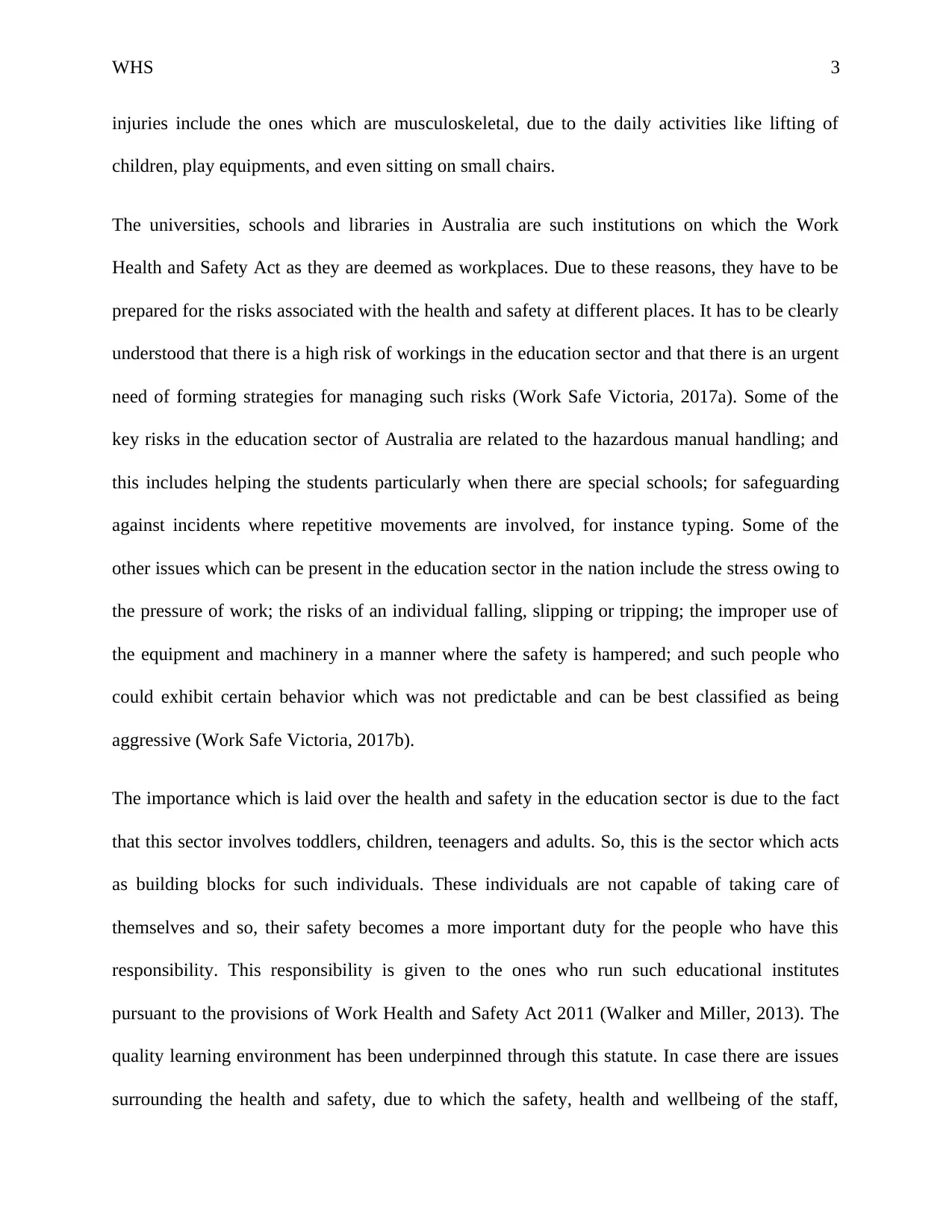
WHS 3
injuries include the ones which are musculoskeletal, due to the daily activities like lifting of
children, play equipments, and even sitting on small chairs.
The universities, schools and libraries in Australia are such institutions on which the Work
Health and Safety Act as they are deemed as workplaces. Due to these reasons, they have to be
prepared for the risks associated with the health and safety at different places. It has to be clearly
understood that there is a high risk of workings in the education sector and that there is an urgent
need of forming strategies for managing such risks (Work Safe Victoria, 2017a). Some of the
key risks in the education sector of Australia are related to the hazardous manual handling; and
this includes helping the students particularly when there are special schools; for safeguarding
against incidents where repetitive movements are involved, for instance typing. Some of the
other issues which can be present in the education sector in the nation include the stress owing to
the pressure of work; the risks of an individual falling, slipping or tripping; the improper use of
the equipment and machinery in a manner where the safety is hampered; and such people who
could exhibit certain behavior which was not predictable and can be best classified as being
aggressive (Work Safe Victoria, 2017b).
The importance which is laid over the health and safety in the education sector is due to the fact
that this sector involves toddlers, children, teenagers and adults. So, this is the sector which acts
as building blocks for such individuals. These individuals are not capable of taking care of
themselves and so, their safety becomes a more important duty for the people who have this
responsibility. This responsibility is given to the ones who run such educational institutes
pursuant to the provisions of Work Health and Safety Act 2011 (Walker and Miller, 2013). The
quality learning environment has been underpinned through this statute. In case there are issues
surrounding the health and safety, due to which the safety, health and wellbeing of the staff,
injuries include the ones which are musculoskeletal, due to the daily activities like lifting of
children, play equipments, and even sitting on small chairs.
The universities, schools and libraries in Australia are such institutions on which the Work
Health and Safety Act as they are deemed as workplaces. Due to these reasons, they have to be
prepared for the risks associated with the health and safety at different places. It has to be clearly
understood that there is a high risk of workings in the education sector and that there is an urgent
need of forming strategies for managing such risks (Work Safe Victoria, 2017a). Some of the
key risks in the education sector of Australia are related to the hazardous manual handling; and
this includes helping the students particularly when there are special schools; for safeguarding
against incidents where repetitive movements are involved, for instance typing. Some of the
other issues which can be present in the education sector in the nation include the stress owing to
the pressure of work; the risks of an individual falling, slipping or tripping; the improper use of
the equipment and machinery in a manner where the safety is hampered; and such people who
could exhibit certain behavior which was not predictable and can be best classified as being
aggressive (Work Safe Victoria, 2017b).
The importance which is laid over the health and safety in the education sector is due to the fact
that this sector involves toddlers, children, teenagers and adults. So, this is the sector which acts
as building blocks for such individuals. These individuals are not capable of taking care of
themselves and so, their safety becomes a more important duty for the people who have this
responsibility. This responsibility is given to the ones who run such educational institutes
pursuant to the provisions of Work Health and Safety Act 2011 (Walker and Miller, 2013). The
quality learning environment has been underpinned through this statute. In case there are issues
surrounding the health and safety, due to which the safety, health and wellbeing of the staff,
⊘ This is a preview!⊘
Do you want full access?
Subscribe today to unlock all pages.

Trusted by 1+ million students worldwide
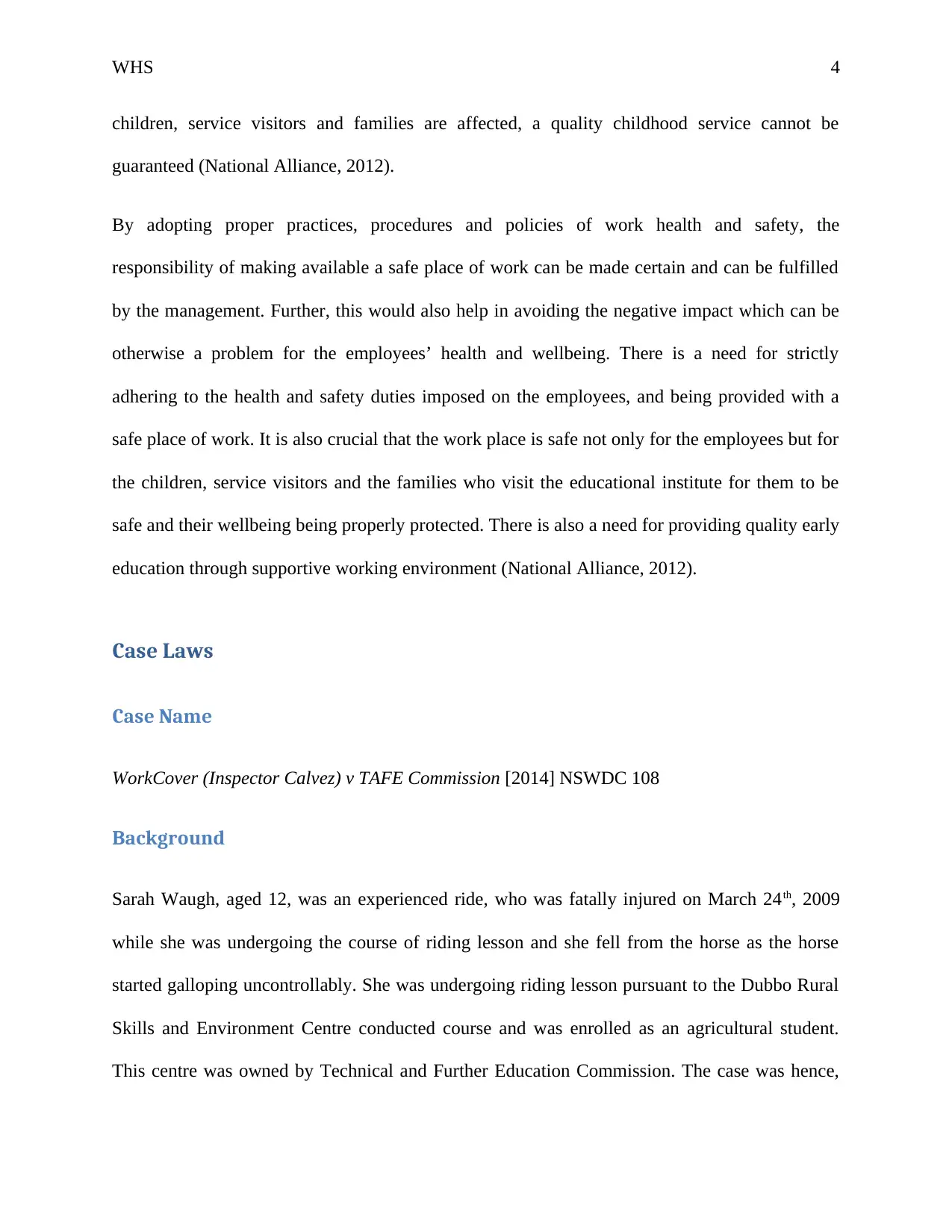
WHS 4
children, service visitors and families are affected, a quality childhood service cannot be
guaranteed (National Alliance, 2012).
By adopting proper practices, procedures and policies of work health and safety, the
responsibility of making available a safe place of work can be made certain and can be fulfilled
by the management. Further, this would also help in avoiding the negative impact which can be
otherwise a problem for the employees’ health and wellbeing. There is a need for strictly
adhering to the health and safety duties imposed on the employees, and being provided with a
safe place of work. It is also crucial that the work place is safe not only for the employees but for
the children, service visitors and the families who visit the educational institute for them to be
safe and their wellbeing being properly protected. There is also a need for providing quality early
education through supportive working environment (National Alliance, 2012).
Case Laws
Case Name
WorkCover (Inspector Calvez) v TAFE Commission [2014] NSWDC 108
Background
Sarah Waugh, aged 12, was an experienced ride, who was fatally injured on March 24th, 2009
while she was undergoing the course of riding lesson and she fell from the horse as the horse
started galloping uncontrollably. She was undergoing riding lesson pursuant to the Dubbo Rural
Skills and Environment Centre conducted course and was enrolled as an agricultural student.
This centre was owned by Technical and Further Education Commission. The case was hence,
children, service visitors and families are affected, a quality childhood service cannot be
guaranteed (National Alliance, 2012).
By adopting proper practices, procedures and policies of work health and safety, the
responsibility of making available a safe place of work can be made certain and can be fulfilled
by the management. Further, this would also help in avoiding the negative impact which can be
otherwise a problem for the employees’ health and wellbeing. There is a need for strictly
adhering to the health and safety duties imposed on the employees, and being provided with a
safe place of work. It is also crucial that the work place is safe not only for the employees but for
the children, service visitors and the families who visit the educational institute for them to be
safe and their wellbeing being properly protected. There is also a need for providing quality early
education through supportive working environment (National Alliance, 2012).
Case Laws
Case Name
WorkCover (Inspector Calvez) v TAFE Commission [2014] NSWDC 108
Background
Sarah Waugh, aged 12, was an experienced ride, who was fatally injured on March 24th, 2009
while she was undergoing the course of riding lesson and she fell from the horse as the horse
started galloping uncontrollably. She was undergoing riding lesson pursuant to the Dubbo Rural
Skills and Environment Centre conducted course and was enrolled as an agricultural student.
This centre was owned by Technical and Further Education Commission. The case was hence,
Paraphrase This Document
Need a fresh take? Get an instant paraphrase of this document with our AI Paraphraser
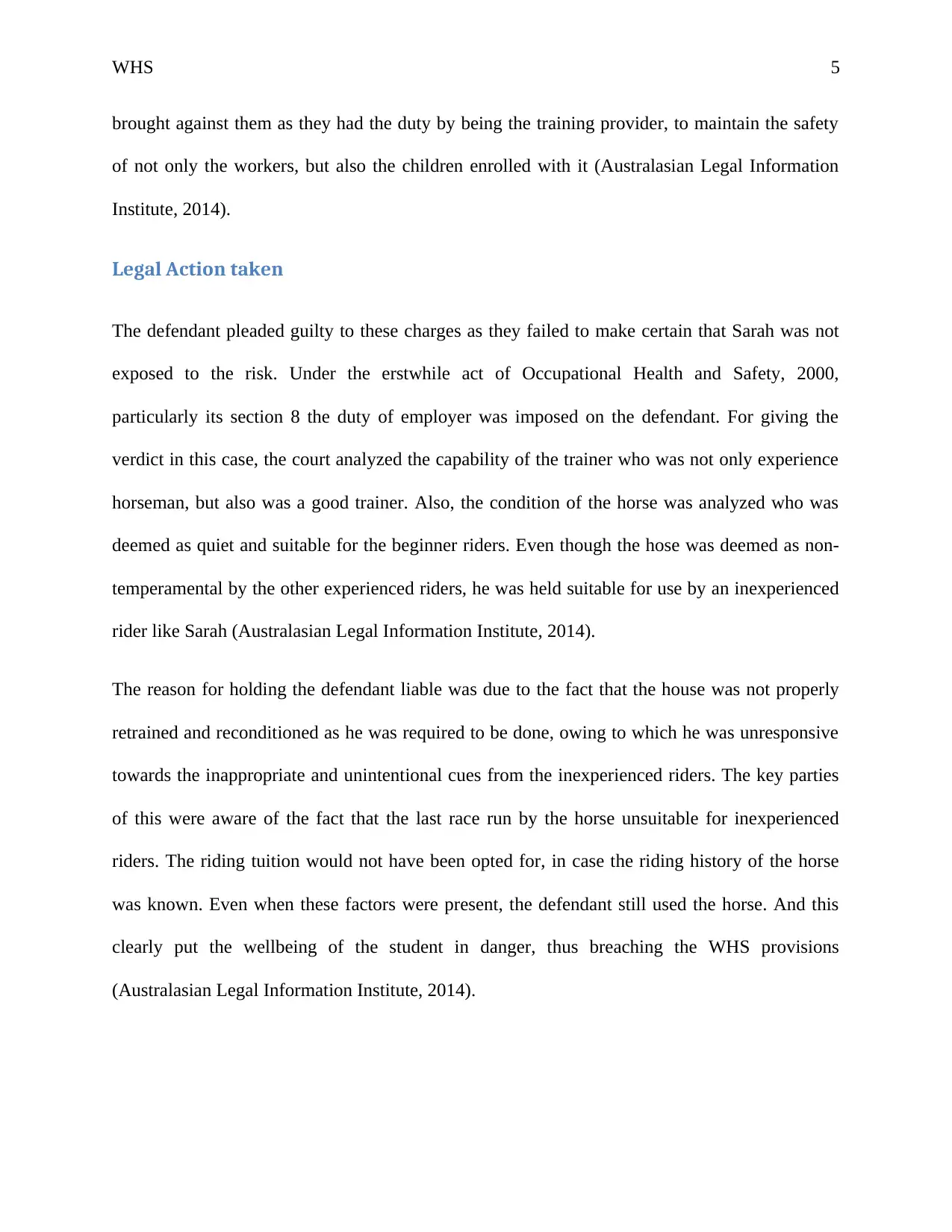
WHS 5
brought against them as they had the duty by being the training provider, to maintain the safety
of not only the workers, but also the children enrolled with it (Australasian Legal Information
Institute, 2014).
Legal Action taken
The defendant pleaded guilty to these charges as they failed to make certain that Sarah was not
exposed to the risk. Under the erstwhile act of Occupational Health and Safety, 2000,
particularly its section 8 the duty of employer was imposed on the defendant. For giving the
verdict in this case, the court analyzed the capability of the trainer who was not only experience
horseman, but also was a good trainer. Also, the condition of the horse was analyzed who was
deemed as quiet and suitable for the beginner riders. Even though the hose was deemed as non-
temperamental by the other experienced riders, he was held suitable for use by an inexperienced
rider like Sarah (Australasian Legal Information Institute, 2014).
The reason for holding the defendant liable was due to the fact that the house was not properly
retrained and reconditioned as he was required to be done, owing to which he was unresponsive
towards the inappropriate and unintentional cues from the inexperienced riders. The key parties
of this were aware of the fact that the last race run by the horse unsuitable for inexperienced
riders. The riding tuition would not have been opted for, in case the riding history of the horse
was known. Even when these factors were present, the defendant still used the horse. And this
clearly put the wellbeing of the student in danger, thus breaching the WHS provisions
(Australasian Legal Information Institute, 2014).
brought against them as they had the duty by being the training provider, to maintain the safety
of not only the workers, but also the children enrolled with it (Australasian Legal Information
Institute, 2014).
Legal Action taken
The defendant pleaded guilty to these charges as they failed to make certain that Sarah was not
exposed to the risk. Under the erstwhile act of Occupational Health and Safety, 2000,
particularly its section 8 the duty of employer was imposed on the defendant. For giving the
verdict in this case, the court analyzed the capability of the trainer who was not only experience
horseman, but also was a good trainer. Also, the condition of the horse was analyzed who was
deemed as quiet and suitable for the beginner riders. Even though the hose was deemed as non-
temperamental by the other experienced riders, he was held suitable for use by an inexperienced
rider like Sarah (Australasian Legal Information Institute, 2014).
The reason for holding the defendant liable was due to the fact that the house was not properly
retrained and reconditioned as he was required to be done, owing to which he was unresponsive
towards the inappropriate and unintentional cues from the inexperienced riders. The key parties
of this were aware of the fact that the last race run by the horse unsuitable for inexperienced
riders. The riding tuition would not have been opted for, in case the riding history of the horse
was known. Even when these factors were present, the defendant still used the horse. And this
clearly put the wellbeing of the student in danger, thus breaching the WHS provisions
(Australasian Legal Information Institute, 2014).
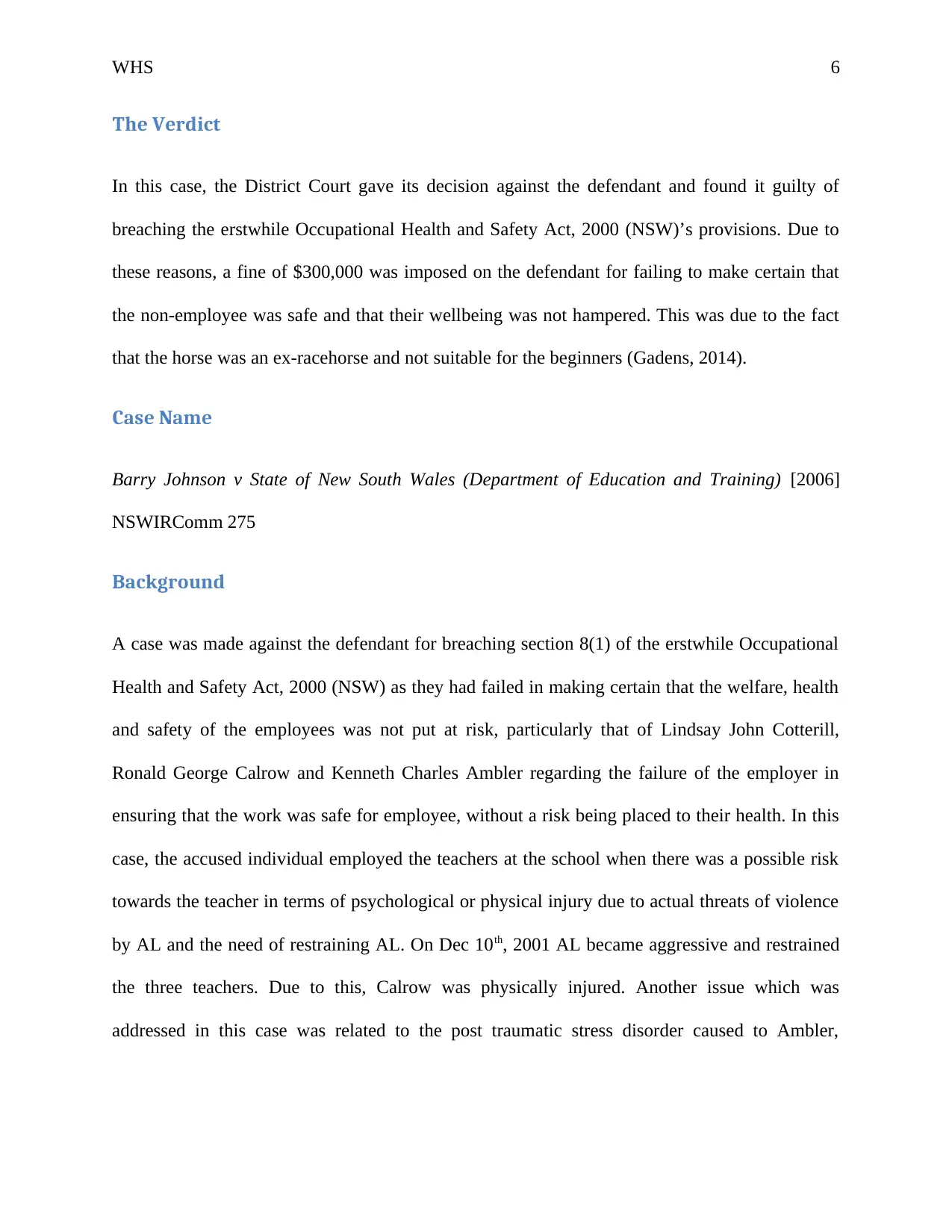
WHS 6
The Verdict
In this case, the District Court gave its decision against the defendant and found it guilty of
breaching the erstwhile Occupational Health and Safety Act, 2000 (NSW)’s provisions. Due to
these reasons, a fine of $300,000 was imposed on the defendant for failing to make certain that
the non-employee was safe and that their wellbeing was not hampered. This was due to the fact
that the horse was an ex-racehorse and not suitable for the beginners (Gadens, 2014).
Case Name
Barry Johnson v State of New South Wales (Department of Education and Training) [2006]
NSWIRComm 275
Background
A case was made against the defendant for breaching section 8(1) of the erstwhile Occupational
Health and Safety Act, 2000 (NSW) as they had failed in making certain that the welfare, health
and safety of the employees was not put at risk, particularly that of Lindsay John Cotterill,
Ronald George Calrow and Kenneth Charles Ambler regarding the failure of the employer in
ensuring that the work was safe for employee, without a risk being placed to their health. In this
case, the accused individual employed the teachers at the school when there was a possible risk
towards the teacher in terms of psychological or physical injury due to actual threats of violence
by AL and the need of restraining AL. On Dec 10th, 2001 AL became aggressive and restrained
the three teachers. Due to this, Calrow was physically injured. Another issue which was
addressed in this case was related to the post traumatic stress disorder caused to Ambler,
The Verdict
In this case, the District Court gave its decision against the defendant and found it guilty of
breaching the erstwhile Occupational Health and Safety Act, 2000 (NSW)’s provisions. Due to
these reasons, a fine of $300,000 was imposed on the defendant for failing to make certain that
the non-employee was safe and that their wellbeing was not hampered. This was due to the fact
that the horse was an ex-racehorse and not suitable for the beginners (Gadens, 2014).
Case Name
Barry Johnson v State of New South Wales (Department of Education and Training) [2006]
NSWIRComm 275
Background
A case was made against the defendant for breaching section 8(1) of the erstwhile Occupational
Health and Safety Act, 2000 (NSW) as they had failed in making certain that the welfare, health
and safety of the employees was not put at risk, particularly that of Lindsay John Cotterill,
Ronald George Calrow and Kenneth Charles Ambler regarding the failure of the employer in
ensuring that the work was safe for employee, without a risk being placed to their health. In this
case, the accused individual employed the teachers at the school when there was a possible risk
towards the teacher in terms of psychological or physical injury due to actual threats of violence
by AL and the need of restraining AL. On Dec 10th, 2001 AL became aggressive and restrained
the three teachers. Due to this, Calrow was physically injured. Another issue which was
addressed in this case was related to the post traumatic stress disorder caused to Ambler,
⊘ This is a preview!⊘
Do you want full access?
Subscribe today to unlock all pages.

Trusted by 1+ million students worldwide
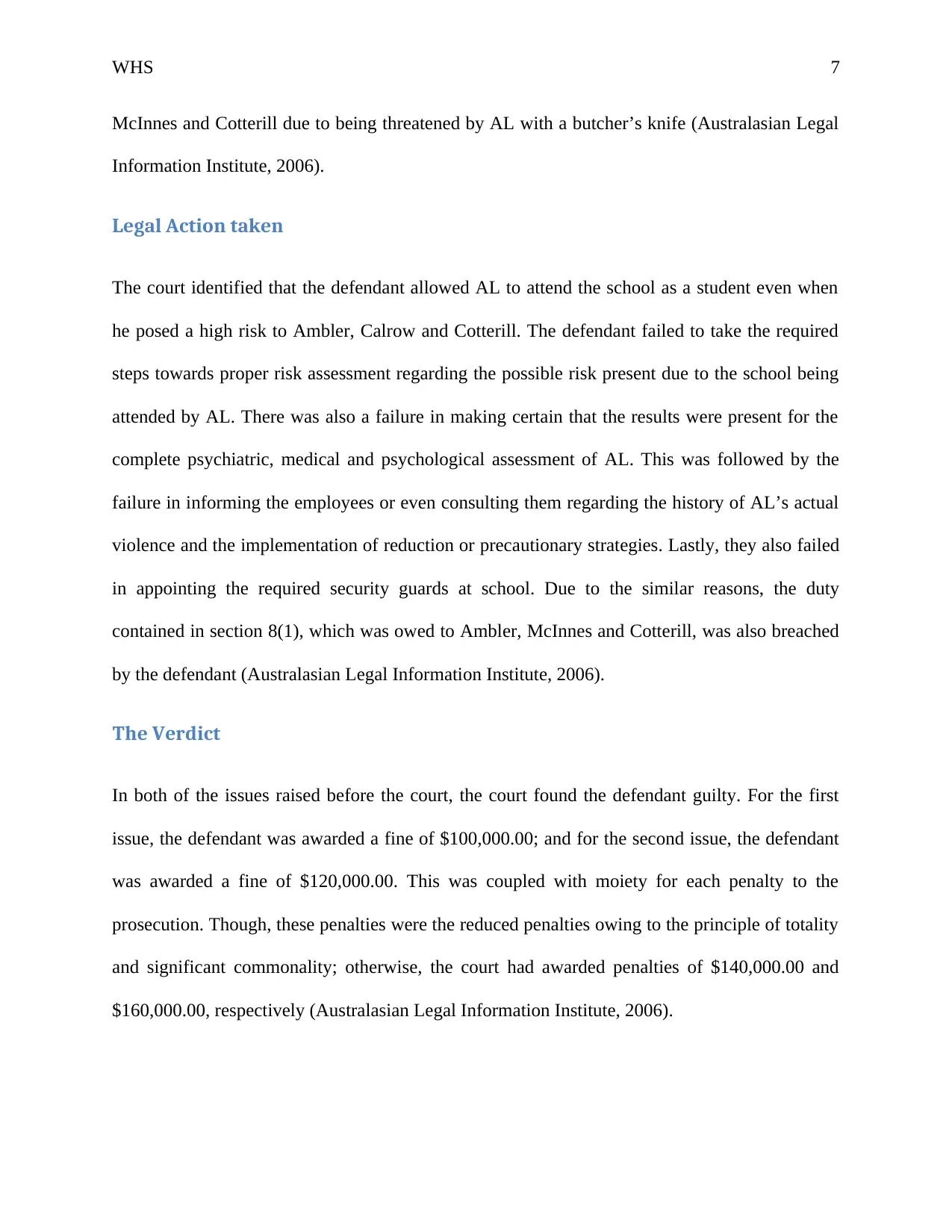
WHS 7
McInnes and Cotterill due to being threatened by AL with a butcher’s knife (Australasian Legal
Information Institute, 2006).
Legal Action taken
The court identified that the defendant allowed AL to attend the school as a student even when
he posed a high risk to Ambler, Calrow and Cotterill. The defendant failed to take the required
steps towards proper risk assessment regarding the possible risk present due to the school being
attended by AL. There was also a failure in making certain that the results were present for the
complete psychiatric, medical and psychological assessment of AL. This was followed by the
failure in informing the employees or even consulting them regarding the history of AL’s actual
violence and the implementation of reduction or precautionary strategies. Lastly, they also failed
in appointing the required security guards at school. Due to the similar reasons, the duty
contained in section 8(1), which was owed to Ambler, McInnes and Cotterill, was also breached
by the defendant (Australasian Legal Information Institute, 2006).
The Verdict
In both of the issues raised before the court, the court found the defendant guilty. For the first
issue, the defendant was awarded a fine of $100,000.00; and for the second issue, the defendant
was awarded a fine of $120,000.00. This was coupled with moiety for each penalty to the
prosecution. Though, these penalties were the reduced penalties owing to the principle of totality
and significant commonality; otherwise, the court had awarded penalties of $140,000.00 and
$160,000.00, respectively (Australasian Legal Information Institute, 2006).
McInnes and Cotterill due to being threatened by AL with a butcher’s knife (Australasian Legal
Information Institute, 2006).
Legal Action taken
The court identified that the defendant allowed AL to attend the school as a student even when
he posed a high risk to Ambler, Calrow and Cotterill. The defendant failed to take the required
steps towards proper risk assessment regarding the possible risk present due to the school being
attended by AL. There was also a failure in making certain that the results were present for the
complete psychiatric, medical and psychological assessment of AL. This was followed by the
failure in informing the employees or even consulting them regarding the history of AL’s actual
violence and the implementation of reduction or precautionary strategies. Lastly, they also failed
in appointing the required security guards at school. Due to the similar reasons, the duty
contained in section 8(1), which was owed to Ambler, McInnes and Cotterill, was also breached
by the defendant (Australasian Legal Information Institute, 2006).
The Verdict
In both of the issues raised before the court, the court found the defendant guilty. For the first
issue, the defendant was awarded a fine of $100,000.00; and for the second issue, the defendant
was awarded a fine of $120,000.00. This was coupled with moiety for each penalty to the
prosecution. Though, these penalties were the reduced penalties owing to the principle of totality
and significant commonality; otherwise, the court had awarded penalties of $140,000.00 and
$160,000.00, respectively (Australasian Legal Information Institute, 2006).
Paraphrase This Document
Need a fresh take? Get an instant paraphrase of this document with our AI Paraphraser
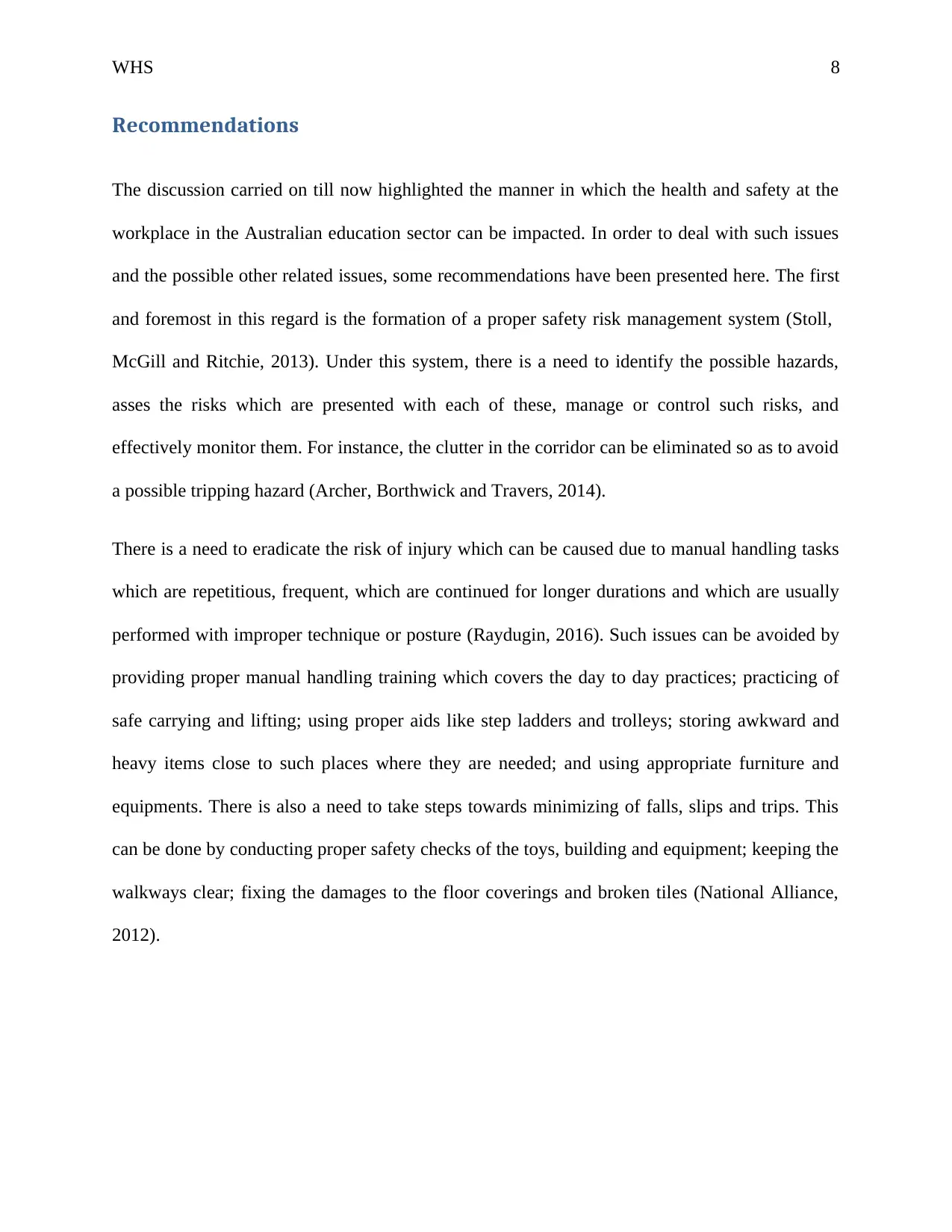
WHS 8
Recommendations
The discussion carried on till now highlighted the manner in which the health and safety at the
workplace in the Australian education sector can be impacted. In order to deal with such issues
and the possible other related issues, some recommendations have been presented here. The first
and foremost in this regard is the formation of a proper safety risk management system (Stoll,
McGill and Ritchie, 2013). Under this system, there is a need to identify the possible hazards,
asses the risks which are presented with each of these, manage or control such risks, and
effectively monitor them. For instance, the clutter in the corridor can be eliminated so as to avoid
a possible tripping hazard (Archer, Borthwick and Travers, 2014).
There is a need to eradicate the risk of injury which can be caused due to manual handling tasks
which are repetitious, frequent, which are continued for longer durations and which are usually
performed with improper technique or posture (Raydugin, 2016). Such issues can be avoided by
providing proper manual handling training which covers the day to day practices; practicing of
safe carrying and lifting; using proper aids like step ladders and trolleys; storing awkward and
heavy items close to such places where they are needed; and using appropriate furniture and
equipments. There is also a need to take steps towards minimizing of falls, slips and trips. This
can be done by conducting proper safety checks of the toys, building and equipment; keeping the
walkways clear; fixing the damages to the floor coverings and broken tiles (National Alliance,
2012).
Recommendations
The discussion carried on till now highlighted the manner in which the health and safety at the
workplace in the Australian education sector can be impacted. In order to deal with such issues
and the possible other related issues, some recommendations have been presented here. The first
and foremost in this regard is the formation of a proper safety risk management system (Stoll,
McGill and Ritchie, 2013). Under this system, there is a need to identify the possible hazards,
asses the risks which are presented with each of these, manage or control such risks, and
effectively monitor them. For instance, the clutter in the corridor can be eliminated so as to avoid
a possible tripping hazard (Archer, Borthwick and Travers, 2014).
There is a need to eradicate the risk of injury which can be caused due to manual handling tasks
which are repetitious, frequent, which are continued for longer durations and which are usually
performed with improper technique or posture (Raydugin, 2016). Such issues can be avoided by
providing proper manual handling training which covers the day to day practices; practicing of
safe carrying and lifting; using proper aids like step ladders and trolleys; storing awkward and
heavy items close to such places where they are needed; and using appropriate furniture and
equipments. There is also a need to take steps towards minimizing of falls, slips and trips. This
can be done by conducting proper safety checks of the toys, building and equipment; keeping the
walkways clear; fixing the damages to the floor coverings and broken tiles (National Alliance,
2012).
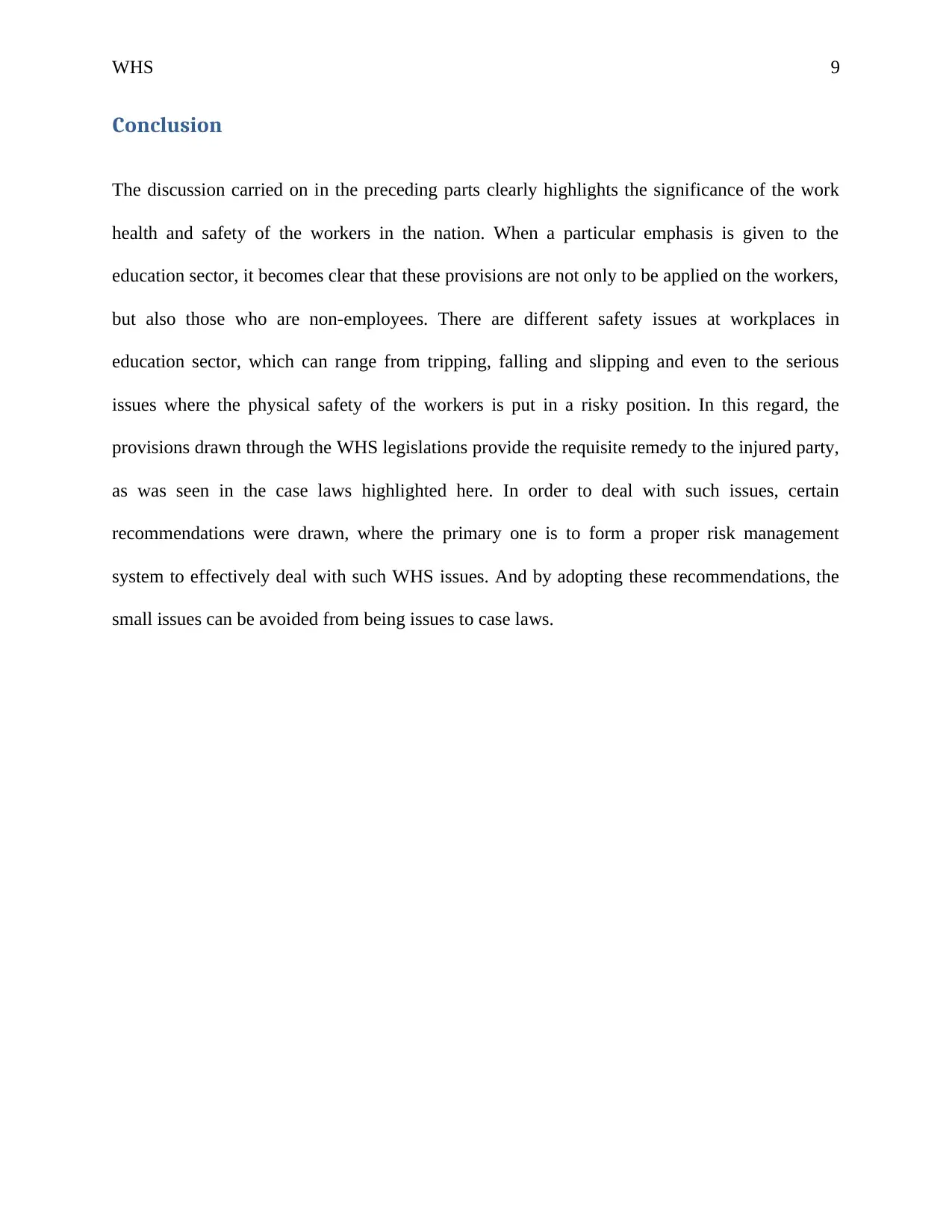
WHS 9
Conclusion
The discussion carried on in the preceding parts clearly highlights the significance of the work
health and safety of the workers in the nation. When a particular emphasis is given to the
education sector, it becomes clear that these provisions are not only to be applied on the workers,
but also those who are non-employees. There are different safety issues at workplaces in
education sector, which can range from tripping, falling and slipping and even to the serious
issues where the physical safety of the workers is put in a risky position. In this regard, the
provisions drawn through the WHS legislations provide the requisite remedy to the injured party,
as was seen in the case laws highlighted here. In order to deal with such issues, certain
recommendations were drawn, where the primary one is to form a proper risk management
system to effectively deal with such WHS issues. And by adopting these recommendations, the
small issues can be avoided from being issues to case laws.
Conclusion
The discussion carried on in the preceding parts clearly highlights the significance of the work
health and safety of the workers in the nation. When a particular emphasis is given to the
education sector, it becomes clear that these provisions are not only to be applied on the workers,
but also those who are non-employees. There are different safety issues at workplaces in
education sector, which can range from tripping, falling and slipping and even to the serious
issues where the physical safety of the workers is put in a risky position. In this regard, the
provisions drawn through the WHS legislations provide the requisite remedy to the injured party,
as was seen in the case laws highlighted here. In order to deal with such issues, certain
recommendations were drawn, where the primary one is to form a proper risk management
system to effectively deal with such WHS issues. And by adopting these recommendations, the
small issues can be avoided from being issues to case laws.
⊘ This is a preview!⊘
Do you want full access?
Subscribe today to unlock all pages.

Trusted by 1+ million students worldwide

WHS 10
References
Archer, R., Borthwick, K., and Travers, M. (2014) WHS: A Management Guide. Victoria:
Cengage Learning Australia.
Australasian Legal Information Institute. (2006) Barry Johnson v State of New South Wales
(Department of Education and Training) [2006] NSWIRComm 275 (15 September 2006.
[Online] Australasian Legal Information Institute. Available from:
http://www.austlii.edu.au/au/cases/nsw/NSWIRComm/2006/275.html [Accessed on: 21/08/17]
Australasian Legal Information Institute. (2014) WorkCover (Inspector Calvez) v TAFE
Commission [2014] NSWDC 108 (14 July 2014). [Online] Australasian Legal Information
Institute. Available from: http://www.austlii.edu.au/au/cases/nsw/NSWDC/2014/108.html
[Accessed on: 21/08/17]
Gadens. (2014) Work Health and Safety Legislative and Case Law Update. [Online] Gadens.
Available from: http://www.gadens.com/News/Documents/Work%20Health%20and%20Safety
%20Legislative%20and%20Case%20Law%20Update.pdf [Accessed on: 21/08/17]
National Alliance. (2012) Work Health and Safety In Education and Care Services. [Online]
National Alliance. Available from:
http://www.ecrh.edu.au/docs/default-source/resources/ipsp/work-health-and-safety-in-education-
and-care-services.pdf?sfvrsn=8 [Accessed on: 21/08/17]
Raydugin, Y. (2016) Handbook of Research on Leveraging Risk and Uncertainties for Effective
Project Management. Hershey, PA, USA: IGI Global.
References
Archer, R., Borthwick, K., and Travers, M. (2014) WHS: A Management Guide. Victoria:
Cengage Learning Australia.
Australasian Legal Information Institute. (2006) Barry Johnson v State of New South Wales
(Department of Education and Training) [2006] NSWIRComm 275 (15 September 2006.
[Online] Australasian Legal Information Institute. Available from:
http://www.austlii.edu.au/au/cases/nsw/NSWIRComm/2006/275.html [Accessed on: 21/08/17]
Australasian Legal Information Institute. (2014) WorkCover (Inspector Calvez) v TAFE
Commission [2014] NSWDC 108 (14 July 2014). [Online] Australasian Legal Information
Institute. Available from: http://www.austlii.edu.au/au/cases/nsw/NSWDC/2014/108.html
[Accessed on: 21/08/17]
Gadens. (2014) Work Health and Safety Legislative and Case Law Update. [Online] Gadens.
Available from: http://www.gadens.com/News/Documents/Work%20Health%20and%20Safety
%20Legislative%20and%20Case%20Law%20Update.pdf [Accessed on: 21/08/17]
National Alliance. (2012) Work Health and Safety In Education and Care Services. [Online]
National Alliance. Available from:
http://www.ecrh.edu.au/docs/default-source/resources/ipsp/work-health-and-safety-in-education-
and-care-services.pdf?sfvrsn=8 [Accessed on: 21/08/17]
Raydugin, Y. (2016) Handbook of Research on Leveraging Risk and Uncertainties for Effective
Project Management. Hershey, PA, USA: IGI Global.
Paraphrase This Document
Need a fresh take? Get an instant paraphrase of this document with our AI Paraphraser
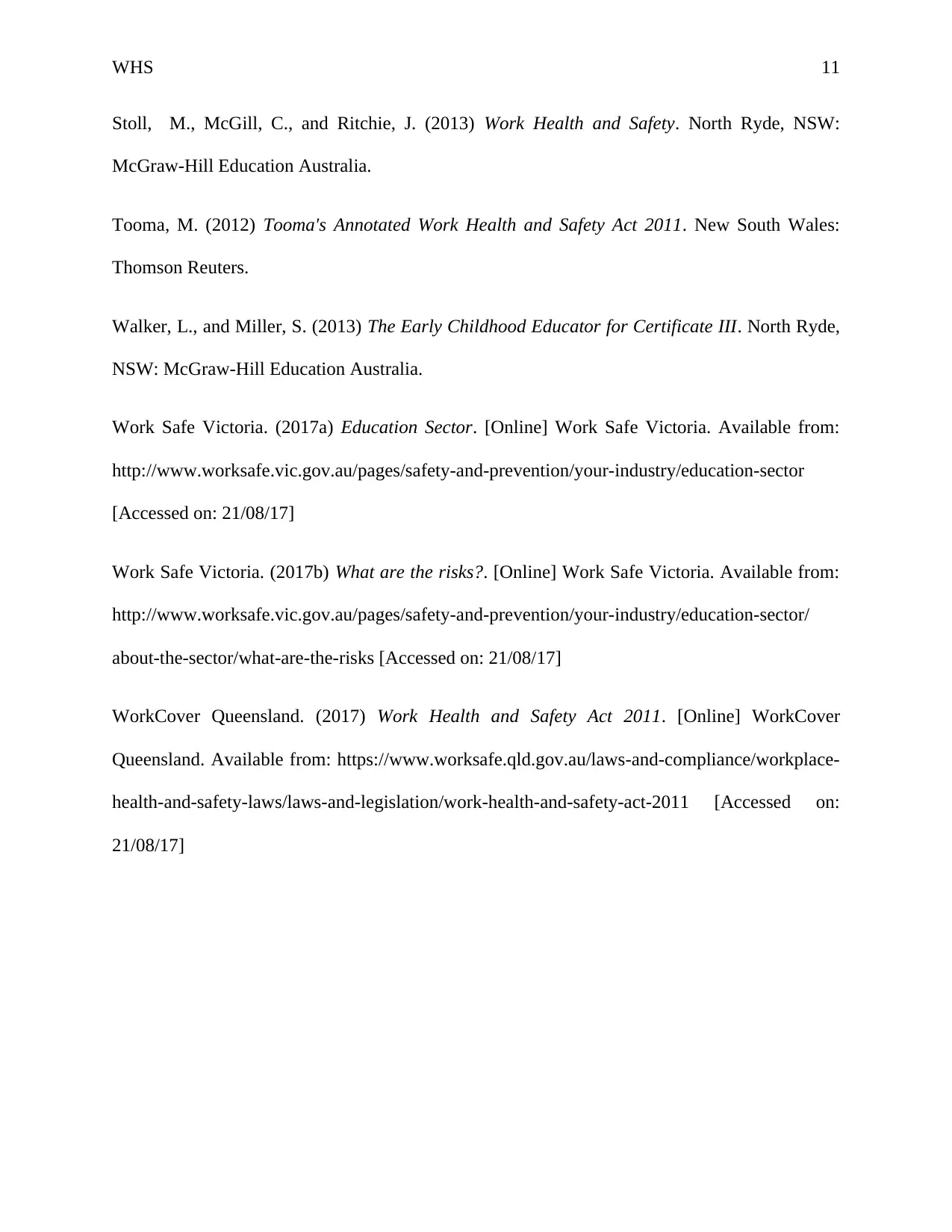
WHS 11
Stoll, M., McGill, C., and Ritchie, J. (2013) Work Health and Safety. North Ryde, NSW:
McGraw-Hill Education Australia.
Tooma, M. (2012) Tooma's Annotated Work Health and Safety Act 2011. New South Wales:
Thomson Reuters.
Walker, L., and Miller, S. (2013) The Early Childhood Educator for Certificate III. North Ryde,
NSW: McGraw-Hill Education Australia.
Work Safe Victoria. (2017a) Education Sector. [Online] Work Safe Victoria. Available from:
http://www.worksafe.vic.gov.au/pages/safety-and-prevention/your-industry/education-sector
[Accessed on: 21/08/17]
Work Safe Victoria. (2017b) What are the risks?. [Online] Work Safe Victoria. Available from:
http://www.worksafe.vic.gov.au/pages/safety-and-prevention/your-industry/education-sector/
about-the-sector/what-are-the-risks [Accessed on: 21/08/17]
WorkCover Queensland. (2017) Work Health and Safety Act 2011. [Online] WorkCover
Queensland. Available from: https://www.worksafe.qld.gov.au/laws-and-compliance/workplace-
health-and-safety-laws/laws-and-legislation/work-health-and-safety-act-2011 [Accessed on:
21/08/17]
Stoll, M., McGill, C., and Ritchie, J. (2013) Work Health and Safety. North Ryde, NSW:
McGraw-Hill Education Australia.
Tooma, M. (2012) Tooma's Annotated Work Health and Safety Act 2011. New South Wales:
Thomson Reuters.
Walker, L., and Miller, S. (2013) The Early Childhood Educator for Certificate III. North Ryde,
NSW: McGraw-Hill Education Australia.
Work Safe Victoria. (2017a) Education Sector. [Online] Work Safe Victoria. Available from:
http://www.worksafe.vic.gov.au/pages/safety-and-prevention/your-industry/education-sector
[Accessed on: 21/08/17]
Work Safe Victoria. (2017b) What are the risks?. [Online] Work Safe Victoria. Available from:
http://www.worksafe.vic.gov.au/pages/safety-and-prevention/your-industry/education-sector/
about-the-sector/what-are-the-risks [Accessed on: 21/08/17]
WorkCover Queensland. (2017) Work Health and Safety Act 2011. [Online] WorkCover
Queensland. Available from: https://www.worksafe.qld.gov.au/laws-and-compliance/workplace-
health-and-safety-laws/laws-and-legislation/work-health-and-safety-act-2011 [Accessed on:
21/08/17]
1 out of 11
Related Documents
Your All-in-One AI-Powered Toolkit for Academic Success.
+13062052269
info@desklib.com
Available 24*7 on WhatsApp / Email
![[object Object]](/_next/static/media/star-bottom.7253800d.svg)
Unlock your academic potential
Copyright © 2020–2025 A2Z Services. All Rights Reserved. Developed and managed by ZUCOL.





